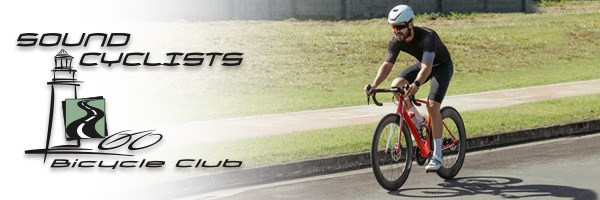Road & Trail Rules
Road Rules Overview
The first illustrated section you see here is a quick overview of what's expected when your are riding on the road and on the trails. Below that will be a more concise listing of the rules that cover just about every situation when riding in a group or by yourself.
Since cyclists have the same rights and obligations when traveling the roadways, so too are they subject to fines for disobeying the law. Traffic summonses may be issued to cyclists for running stop signs and red lights or riding on the wrong side of the road.
All cyclists are obligated by law to obey all traffic signals. Cyclists have as much right to the roadways as motor vehicles and must abide by the same rules and regulations as motorists.
All cyclists must stop at all marked intersections. At all intersections, with or without stop signs, cyclists should yell car left or car right to other cyclists if cars are approaching from either of those directions.
One thing that cannot be stressed enough is riding single file, especially in high traffic areas and on narrow roads. During cycling tours, stay to the right and ride single file.
Before making a left turn, first check traffic to see if any cars are coming, then fully extend your left arm and point in that direction. Signal well in advance of the actual turn, and then position your bike so that traffic can move around you.
When making a right turn, fully extend your right arm and point in the intended direction. Some cyclists signal a right turn by holding their left arm out with the forearm pointing up. Either way is correct. You should signal well in advance of the actual turn, and then use both hands to steer through the turn.
If there is debris or a hazard in the road, fully extend your arm and point to the hazard. Sometimes moving your arm while pointing draws more attention to the debris. Potholes, branches, glass, sand, storm drains, etc. should all be called out verbally as a courtesy to riders in the rear.
When slowing or stopping, fully extend your arm down and out with the palm of your hand facing those who might be behind you. Call out slowing or stopping, while displaying your hand signal to forewarn riders behind that you are slowing or stopping.
When passing, call up to the rider you are passing and announce, on your left. Check that you are not cutting off another rider and only pass on the left, leaving about three feet of clearance. If you are being passed, continue straight, do not turn and look back.
When a car is approaching from behind, call out to the riders up ahead of you, car back. This warning should be passed along by each rider to the front of the group until there is no one left to warn. On hearing this warning, move to the right and ride single file.
When a car is approaching from ahead, call out to the riders behind you, car up. This warning should be passed along by each rider to the back of the group until there is no one left to warn. On hearing this warning, move to the right and ride single file.
Trail Rules Overview
Unlike riding on the road, the rules are very different on trails and they vary depending on where you ride..
Ride on open trails only. Respect trail and road closures and avoid possible trespass on private land. Stay on existing trails and do not create new ones.
Leave no trace of your presence. Be sensitive to the trails you ride. You should not ride under conditions where you will leave evidence of your passing. Don't skid. Take turns and climb hills slowly enough to avoid trail marks.
Control your bike. Inattention for even a second can cause problems. Obey all bicycle speed regulations and recommendations. Bikers should space out on grades to allow riders use of the full width of the trail to select the best line of approach.
When encountering hikers head on, stop and pull over. If approaching from the rear, greet them, or sound a bell, then pass. Be friendly to land managers, hikers and equestrians. When encountering equestrians from the front, stop, get off your bike and move well off the trail until they pass. When approaching from the rear, ask permission to pass and ask for advise as to the best way to pass.
Never spook animals. All animals are startled by unannounced approach, a sudden movement, or a loud noise. Give animals extra room and time to adjust to you. Disturbing wildlife is a serious offense. Leave gates as you found them, or as marked.
Plan ahead. Know your equipment, your ability, and the area in which you are riding. Be self-sufficient at all times and keep your equipment in good repair. Carry necessary supplies for changes in weather or other conditions. Always wear a helmet!
Get involved with trail maintenance by using your spare time to clean up and repair the trails you ride.
Getting Down to the Specifics
Basics
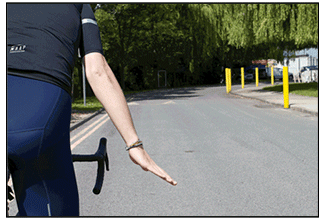
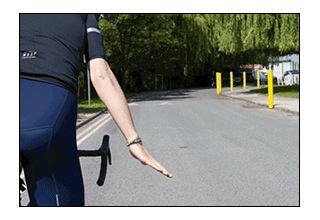
- Ride on the right side of the road, as far to the right as practical and the cyclist deems safe. Ride single file.
- Use hand/and or verbal signals to alert motorists and other cyclists of your intention to turn or slow down.
- Be alert for hazards in the road – potholes, branches, debris, animals – and call out to those riding with you.
- Always try to pass others on their LEFT, and call out before passing.
- Be courteous and allow three feet when passing a fellow cyclist, and call out "passing on your left."
- Always yield to pedestrians, and slow to a walking pace if safety dictates.
- Be aware at all times. Riding is not the time to daydream.
Anticipate
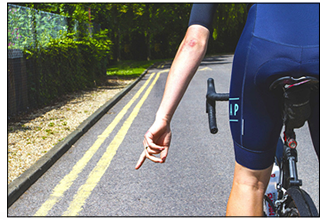
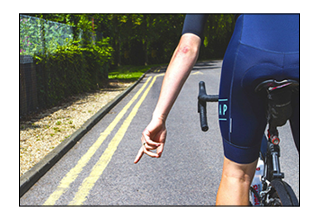
- Don't wait until the last moment to move – don't ride up to a hazard and then jerk around it; go around it in a smooth sweep and direct riders behind you around it.
- On downhills continue to pedal if you are in the lead.
- Do not yo-yo – that is, slow down, speed up, slow down, speed up. Keep a consistent speed.
- When regrouping, stay in single file on the side of the road. Do not bunch up. Make sure you and your entire bike are out of the lane of travel. Do not lean into the lane of travel.
Communicate
- Use hand signals to indicate turns (left and right), stopping and slowing.
- Use verbal warnings. This includes warnings for turns, stopping and slowing.
- "Car Up" – To warn of approaching vehicles.
- "Car Back" or "Coming Around" – To warn of passing vehicles.
- "On your left" - When overtaking an unsuspecting cyclist.
- Pass all communications up or down the line of riders.
- Never slow down or stop unexpectedly – communicate "slowing" or "stopping." If you slow down or stop unexpectedly, you may cause a pile up behind you. Always assume that there is someone right behind you.
- Getting in line or coming up right behind another rider – "I"m right behind you" or "on your wheel" – let riders know that you are there.
- "Standing" – standing tends to slow you down so warn riders behind you.
Don't Overlap Wheels
- This habit will get you in real trouble. Some people do it from lack of concentration, others may just not know any better, but sooner or later they'll crash. There is no recovery from a front wheel deflection. All it takes is for the person in front to move sideways a few inches; if someone is overlapping his wheel, that someone will go down along with practically everyone who is behind him. Many times the person in front can recover, but not the people behind.
Hold Your Line
- Ride in a straight, steady line - don"t be a squirrel weaving all over the road - [Hint: use your peripheral vision and the white line/curb on the side of the lane to keep a consistent straight line].
- Keep a safe distance that you are comfortable with between you and the rider ahead of you. Note that on faster rides, riders tend to ride closer to each other. Don"t leave more than a bike length between you and the rider ahead, except as needed downhill. If you are not comfortable in a paceline, you should ride off the back.
- Stay on one side of the white line – ride just to the left of the white line or on the shoulder if the shoulder is wide, clean and sustained – and keep a steady, straight line. By doing this you are predictable to other riders and to cars. Weaving back and forth across the white line is unpredictable.
- At traffic lights and stop signs, stay single file. Never bunch up. It is not the time to pass anyone.
Passing
- Look back before passing – don't just pull out. Look, communicate, then move.
- Tell every rider that you pass that you are passing – even when you are part of a group passing another group, particularly if you are a straggler.
- Hold your line if you are being passed on climbs, and stay to the right unless passing.
Pacelining
- When pulling at the front, maintain the speed of the group. Do not stay on the front so long that you decrease the speed of the group. Keep the pace steady!!
- If you are the last rider in the paceline call out "last" to let the rider drifting back know the paceline will end with you.
- Be careful not to slow down too much, otherwise you will have to accelerate hard to maintain contact with the group or miss the group all together.
- When pacelining, stay in line until you reach the front. When you are in the front and prepare to pull off, look for cars and then signal to the riders behind you. When you pull off, drift to the very back of the paceline. Try not to allow "gaps" to occur except as need on downhills.

